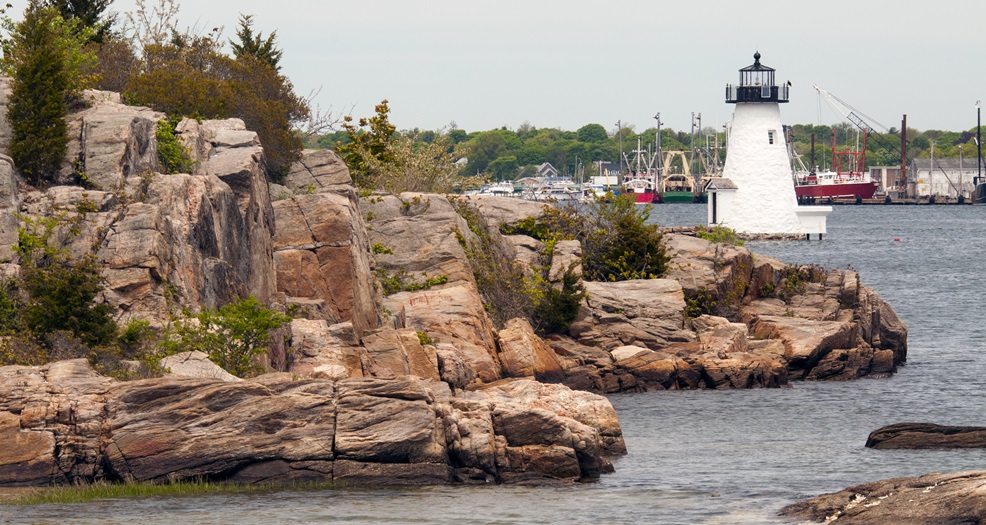New Bedford is a city of about 95,000 folks, making it the sixth-largest city in Massachusetts. It’s nicknamed “The Whaling City“: in the 19th century, the city was possibly the most important whaling port in the world. It’s chief competition for that title would have been Nantucket, Massachusetts and New London, Connecticut.
Europeans first settled New Bedford in 1652, and the economy prospered for a long time based on fishing and whaling. In Moby Dick, author Herman Melville said, “The town itself is perhaps the dearest place to live in, in all New England… nowhere in all America will you find more patrician-like houses, parks and gardens more opulent, than in New Bedford.”
But the city fell on hard times when whale populations collapsed. Many whalers quit their jobs in 1849 as the California Gold Rush attracted them to what they imagined was easier, safer, more lucrative work. The economy fell again later on when the cod populations collapsed, and suffered yet another major setback during the Bush administration’s 2008 recession.

Mayor Jon Mitchell. Photo credit: City of New Bedford.
But, since three-term New Bedford, Massachusetts mayor Jonathan F. Mitchell took office, the city has made a remarkable economic recovery, and seems poised for continued growth.
During his administration, Mitchell has pressed for federal and state aid to revitalize the port, and for other renewal projects. Most recently, he is excited about a deal the city announced in May of 2017 with MassDevelopment, the state’s economic development agency. They are going to repurpose 100 acres of the Whaling City Golf Course into a far-more useful industrial park. A city-owned nine-hole course will remain on the leftover property.
Mitchell has also been encouraging restoration and reuse of historic buildings, as well as cleaning up the downtown areas where they are centered. He says that “investment in historic preservation is going to be ramped up in a big way in next few months.”
The city in 2015 adopted a Community Preservation Act, allowing imposition of a fee on New Bedford businesses. “We’ve raised a considerable amount of money in last two years, about $2 million, that we hope will leverage more private sector dollars to preserve important historic properties,” added the mayor.
The heritage-based revitalization effort will focus in and around the New Bedford Whaling National Historical Park established by Act of Congress in 1996. The 13-block area surrounds the Whaling Museum, which itself recently opened a privately financed $8 million expansion, greatly increasing space for educational programs.
The downtown area has seen a surge of investment in small restaurants, to the point where the area–until recently dark and dead at night–is now thriving.
Mitchell hopes the knowledge economy will grow in what he is calling “innovation districts” in the downtown area (a concept championed by urban expert Bruce Katz and others at the Brookings Institution). He described the basic idea thus: ”developing around an anchor institution those things that would cultivate a start-up environment—makerspaces or incubators, along with some residential density, and small businesses, coffee shops and the like so that people can feel they are part of vital community engaged in active exchange of ideas.”
of course, good leadership at the local level doesn’t always translate into good leadership at higher levels. In an example of why strong federal leadership is often needed to protect and restore shared natural resources, Mitchell has voiced skepticism about the Obama administration’s decision, announced in September of 2016, to designate 4,913 square miles off the New England coastline as a new marine national monument.
The new Northeast Canyons and Seamounts Marine National Monument lies 130 miles off the southeast coast of Cape Cod, and has been for many years an active fishery. Of course, when you’re at Ground Zero of the economic pain by caused by such necessary decisions, it’s easy to understand why a mayor would put the welfare of his city above that of the region, the country, or the planet. This is just one of many vital national monuments that the current U.S. Congress is working to reopen to unsustainable exploitation.
That doesn’t make him an anti-environmentalist, however. One of his revitalization strategies is to make New Bedford a center of research and development for offshore wind energy. “Our big initiatives include more investments in the port, especially those assets that can facilitate the development of the offshore wind industry here,” he said.
But the city’s fishing industry is far from gone. New Bedford’s waterfront boasts:
- 30 commercial fish and shellfish processors and distributors
- New England’s largest fishing fleet
- 50 million pounds of sea scallops caught annually outside of the harbor
- Port service industries including, but not limited to, ship chandleries, ice houses, welders, net designers, boatyards, gear builders, engineers, maritime attorneys, insurance brokers, settlement houses
- The nation’s last remaining fish auctions
- 117 million pounds of fishing products with $369 million in direct sales in 2011
- A protected deepwater harbor with a hurricane barrier
- A location as a hub in the American Marine Highway.
Seeing as fishing is the city’s largest industry, it is perhaps surprising that the harbor is also one of Environmental Protection Agency’s (EPA) largest Superfund sites. From the 1940s through the 1970s, Aerovox Corp, now known as AVX, dumped carcinogenic PCBs into the harbor from its transformer plant.
The EPA placed the harbor and surrounding sites on the Superfund list in 1982 after closing the harbor to fishing and shellfishing in the late 1970s. A settlement in early October of 2012 found AVX liable for damages and responsible for $336.25 million plus interest for harbor cleanup.
This will be the largest single-site cash settlement in the history of the Superfund program, and will reduce the cleanup timeline of the most contaminated sections from 40 years to approximately six years: yet another element of New Bedford’s multi-faceted revitalization.
Photo of New Bedford harbor via Adobe Stock.

